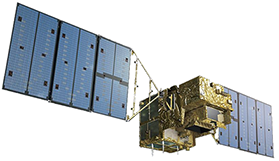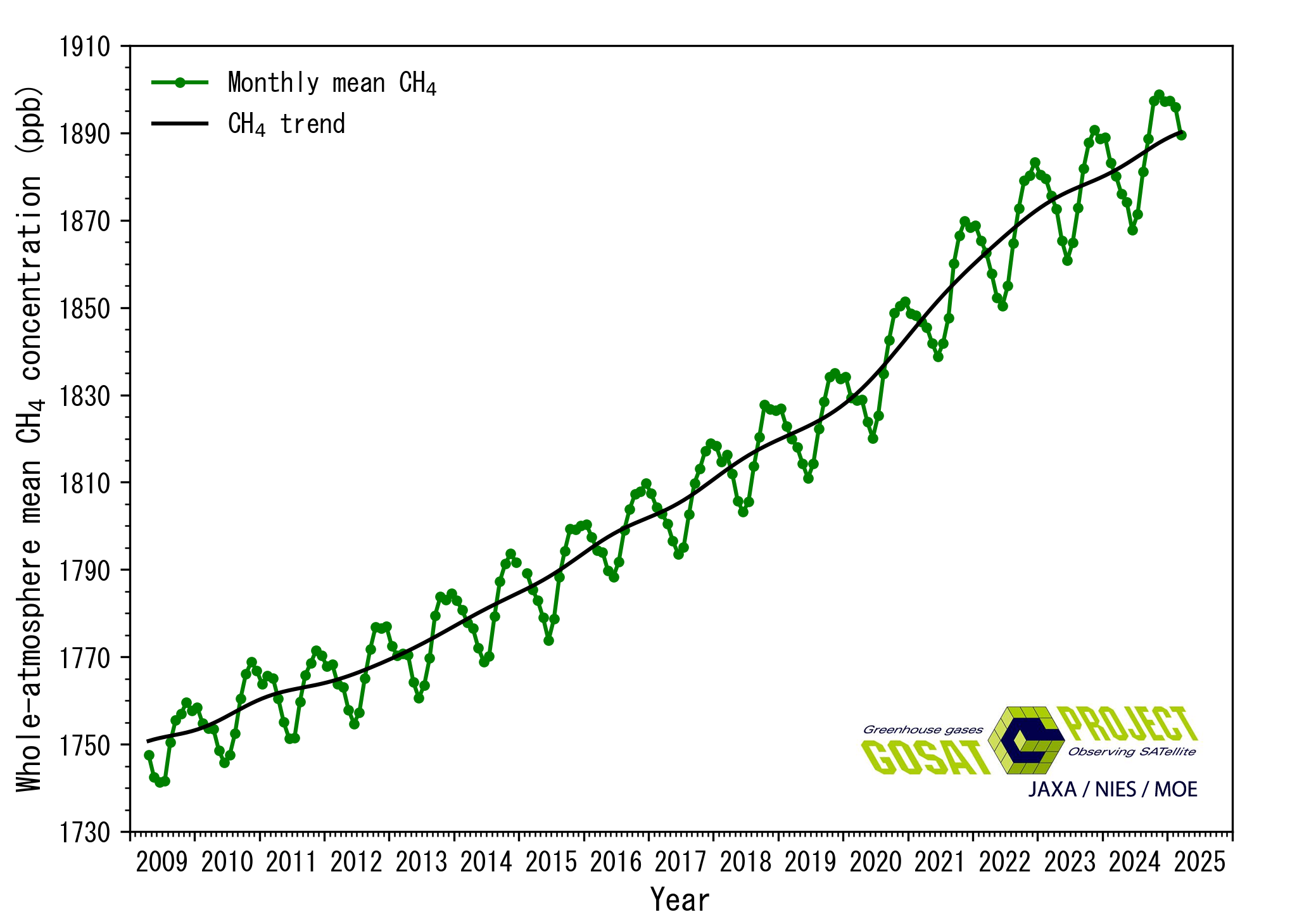
Monthly mean CH4
November 2025
1904 ppb
CH4 trend (1)
November 2025
1892 ppb
CH4 growth over the past year (2)
November 2025 - November 2024
5 ppb/yr
Notes:
(1) CH4 trend is a value on the CH4 trend line derived by removing averaged seasonal fluctuations from the monthly CH4 time series. Please note that with a new addition of monthly mean CH4 data, seasonal fluctuations may vary. Accordingly, past CH4 trend values can also change slightly.
(2) CH4 growth refers to an increase of CH4 level on the trend line over the past year.
The project of the Greenhouse gases Observing SATellite "IBUKI" (GOSAT), the world’s first satellite designed specifically for monitoring greenhouse gases from space, is jointly promoted by the Ministry of the Environment, Japan, the National Institute for Environmental Studies, and Japan Aerospace Exploration Agency. The satellite has been in operation since its launch on January 23, 2009.
The above chart demonstrates the whole-atmosphere monthly mean concentration of methane (CH4), calculated by using GOSAT data that reflect CH4 levels in all layers of the atmosphere. It is also showing seasonal fluctuations and yearly rise over the analyzed period. It is also confirmed that the trend line of the whole-atmosphere CH4 mean (average seasonal cycle removed) increases monotonously. The value and the growth of the trend line are important to discuss global warming issues.
Whole-atmosphere monthly mean methane concentration
Characteristics and significance of greenhouse gas observation by GOSAT
Greenhouse gas changes at surface-level monitoring sites and the global CH4 mean based on those observations have long been reported by the World Meteorological Organization and several other meteorological agencies around the world. However, greenhouse gas levels, and thus CH4 levels, are known to vary with altitude from past measurements taken by aircraft. Therefore, for a further understanding of overall trends for CH4 in the atmosphere, it is necessary to know “whole-atmosphere” CH4 mean. Model predictions of whole-atmosphere CH4 mean have appeared in the fifth assessment report by the Intergovernmental Panel on Climate Change, as they are important for predicting the risk of global warming due to rising greenhouse gas levels. This is where CH4 observation by GOSAT comes in useful, as the satellite measurement encompasses levels from the surface to the top of the atmosphere and provides CH4 concentration averaged over an entire atmospheric column (this is referred to as column-averaged CH4 concentration).
Whole-atmosphere monthly mean CH4 concentration based on GOSAT data
The whole-atmosphere mean CH4 concentration was calculated based on GOSAT measurement, using observational data collected by the satellite since April 2009. During the analyzed period, the monthly mean CH4 concentration had continuously risen with the seasonal fluctuation characterized by a minimum in early- to mid-summer (May to July) and a maximum in late autumn to winter (November to February). In January 2018, the whole-atmosphere mean CH4 concentration reached the record of 1824 ppb. Furthermore, the trend line also reached 1817 ppb in January 2018. We note that the whole-atmosphere mean CH4 concentration calculated here is an estimation made using the model approach based on GOSAT data as areas that GOSAT measurement can cover are limited to parts of the globe where the local solar altitude is above a specific threshold and not covered by any clouds (3). The figure shown here represents the monthly mean CH4 concentration and the trend line calculated from it (4) . Although, the values shown here are found to be smaller by 40 ppb than those based on CH4 measurements at the surface level, it is consistent with the fact that CH4 concentration becomes lower as it is dispersed in the air (5).
Notes:
(3) Please refer to the header of the data file for the version of GOSAT FTS SWIR Level 2 CH4 column amount products used to calculate the whole-atmosphere monthly mean CH4 concentration.
(4) Result for January 2015 is missing due to lacking data for instrument adjustment.
(5) Follow the link below for further information on data released by the US National Oceanic and Atmospheric Administration:
https://www.esrl.noaa.gov/gmd/ccgg/trends_ch4/
[Contact Information]
NIES Satellite Observation Center, GOSAT Project
Phone: +81-29-850-2966
The GOSAT Project is a joint effort of the Ministry of the Environment (MOE), the National Institute for Environmental Studies (NIES), and the Japan Aerospace Exploration Agency (JAXA)
Privacy Policy | Link | Glossary
Copyright © National Institute for Environmental Studies. All Rights Reserved.

















